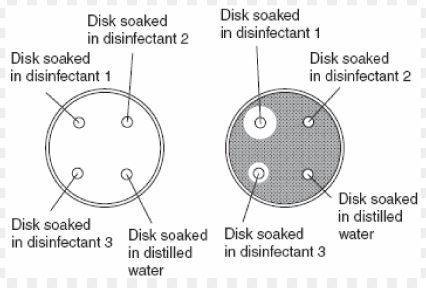
Biology, 19.07.2019 13:10 naomihiggins4033
Astudent placed a disk of filter paper in each of the following solutions: disinfectant 1, disinfectant 2, disinfectant 3, and distilled water. while the four disks were soaking in their respective solutions, she streaked a sterile nutrient agar dish with a culture of e. coli bacteria. then, she placed each disk carefully onto the nutrient agar dish, placed the lid on the dish, taped it shut, and incubated the dish at 37°c for several days. the diagram shows how the nutrient agar dish looked on day 1 and day 4. the shaded portion of the plate on day 4 indicates the bacterial growth. look at the dishes in the diagram. which disinfectant was the most effective at controlling the growth of e. coli? a. disinfectant 2 b. disinfectant 1 c. distilled water d. disinfectant 3

Answers: 1


Other questions on the subject: Biology


Biology, 21.06.2019 23:30, connorgking
Complete the sentences by matching the names of trees to the appropriate blanks. to do this, drag the names on the left into the appropriate blanks in the sentences on the right. match the words in the left column to the appropriate blanks in the sentences on the right. terms may be used more than once. make certain you have filled every blank with a term before clicking submit. 1. deciduous trees lose their leaves seasonally and include trees such as maple and elm. 2. conifer leaves are generally thin and needle-like, while seeds are contained in cones. conifers include cedar and pine. 3. evergreens are plants that maintain their leaves in all seasons and include trees such as cedar, elm, and pine. 4. hardwoods reproduce using flowers and have broad leaves; hardwoods include trees such as maple, , and cedar. elm returned you filled in 2 of 10 blanks incorrectly. mango trees are tropical broad leaf plants that maintain their leaves all year long. no credit lost. try again.
Answers: 2

Biology, 22.06.2019 11:30, cr22estiles
What would most likely happen if green plants were exposed to longer days of sunlight? a. the mitochondria would produce less energy . b. the chloroplasts would produce more energy. c. the cell wall would become thicker. d. the vacuoles would quickly shrink. b. the chloroplasts would produce more energy.
Answers: 3
You know the right answer?
Astudent placed a disk of filter paper in each of the following solutions: disinfectant 1, disinfec...
Questions in other subjects:


Chemistry, 15.01.2021 23:40



History, 15.01.2021 23:40

Arts, 15.01.2021 23:40

History, 15.01.2021 23:40

Mathematics, 15.01.2021 23:40

English, 15.01.2021 23:40




